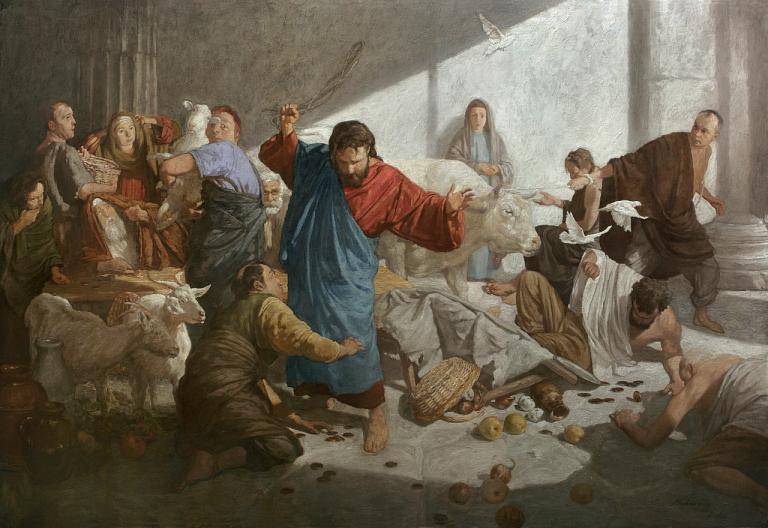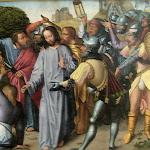
It’s fascinating how many Christians argue for a violent Jesus. In spite of the fact that all throughout his ministry, Jesus told his listeners to do things like love their enemies, bless those who persecute them, turn the other cheek, and so on, some Jesus-followers still insist that Jesus was, in so many ways, okay with violence. One place they generally turn to as proof is the so-called “cleansing of the Temple” (cf. Mark 11:15–19, 27–33; Matt 21:12–17, 23–27; Luke 19:45–48, 20:1–8; John 2:13–16).
In this piece, I’d like to show how this is an ill-advised move.
First off, I will admit that in this scene, Jesus does use force to make a point. In fact, he uses so much force that tables get flipped over in dramatic fashion. In John’s version, he even makes a whip of cords that some commentators believe was used to whoop up on some money-changer-ass. But that would be to read something into the text that is simply not there. John doesn’t tell us that Jesus whipped people. Rather, it seems much more reasonable to believe he did what anyone would do if they wanted to drive animals from one place to another: he made a whip of cords, perhaps yelled the Jewish version of “Giddy up, yaw!” and out the sheep and cattle went. This is an anti-sacrificial move, if it is anything.
Nevertheless, some still insist that what Jesus did was violent, that it shows how angry and hostile Jesus will get when you piss him off. But is this so?
Well, not quite. He is much cooler and more calculated than that.
You see, Jesus was a prophet, and as such, often quoted the prophets before him. In fact, just prior to entering the Temple he quotes from Jeremiah 7. Why is this important? Because, just like Jeremiah, Jesus is extremely grieved that his people are about to have their entire world come crashing down at the hands of foreign armies. He foresees their fate and feels obliged to create a dramatic display of what is going to happen within that generation (Luke 21:32; Matt 24:34).
Jeremiah did the same thing hundreds of years prior. In Jeremiah 19, God tells the prophet to “violently” destroy a ceramic jar at the gate that leads to the Valley of Hinnom/Gehenna/Hell. Then, he heads to the Temple to do the same thing. All this represents what the Babylonians are about to do to Jerusalem, which is that they are going to lay waste to everything, including their beloved Temple system.
So, was Jeremiah being violent when he destroyed the ceramic jar? I suppose, if that is how you want to define violence. But it’s not how the Bible defines it. As my friend Brad Jersak teaches: “Throughout the Bible, the word ‘violence’ is associated with injustice, bloodshed and death.” None of that is going on here. And none of that was going on when Jesus essentially performed the same drama.
In fact, it’s quite the opposite.
You see, within 40 years of this event, everything Jesus dramatized—and Jeremiah before him—within the walls of the Temple actually comes to pass. Only much, much worse. Not only are the tables turned over in 70 CE, but every brick comes down. Not only are all the animals driven out, but everything that is breathing is utterly destroyed and literally thrown into the Valley of Hinnom/Gehenna/Hell, where their bodies are burned in a “lake of fire.”
That is violence. Jesus just warned his people about it, not simply by saying “Hey, guys, the Romans are going to destroy you all soon if you don’t change your ways,” but by showing them exactly what is going to happen: tables are going to be overturned; the priests and attendants, along with all the sacrificial animals, are going to be driven out and/or killed; and, to reiterate, everyone is going to end up in the Valley of Hinnom/Gehenna/Hell just like they did after they failed to listen to Jeremiah.
To that end, my advice to my fellow brothers and sisters in Christ who believe Jesus was being violent in this scene is this: interpret it through the lens of Jesus’ entire ministry, not the other way around. Duh, right? Most specifically, interpret it through the lens of the Sermon on the Mount, as well as Jesus’ warning that “those who live by the sword will die by the sword.” Don’t just assume Jesus is violent because he uses force during a dramatization. That is not at all the point of this story, so please stop trying to say it is. In fact, the point of the story is quite the opposite. It is a warning that if we are going to continue in our violent and sacrificial ways, then we are going to end up burning in a lake of fire at the hands of those who are running the political show.
May we begin to see this.
Peace, and stay tuned for Part 2.













